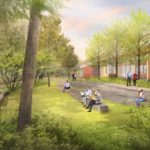
By Marty Bitner and Clair Colburn The proposed new library, designed by Oudens Ello Architecture, is an all-electric, highly sustainable building, but what are those sustainable features? What is the process of designing a holistically sustainable building? Right-Sizing Buildings contribute to 40% of global energy consumption and 33% of greenhouse gas emissions. Since heating buildings is the largest source of carbon emissions in Belmont, the first goal in sustainability is to make sure that our new library is no larger than it needs to be. Having the right size building means that space is not being unnecessarily heated and cooled [READ MORE]



